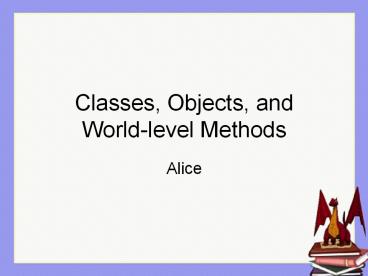Classes, Objects, and World-level Methods - PowerPoint PPT Presentation
1 / 18
Title:
Classes, Objects, and World-level Methods
Description:
... snowman tries to get the attention of the snowwoman blink eyes ... Why? Why do we want to write our own methods? saves time ... – PowerPoint PPT presentation
Number of Views:71
Avg rating:3.0/5.0
Title: Classes, Objects, and World-level Methods
1
Classes, Objects, and World-level Methods
- Alice
2
Larger Programs
- As you become more skilled in writing programs,
you will find that programs quickly increase to
many, many lines of code. - Games and other "real world" software
applications can have thousands, even millions of
lines of code.
3
Classes, Objects, Methods
- Object-oriented programming uses classes,
objects, and methods as basic programming
components. - These components help to
- organize a large program into small modules
- design and think about an intricate program
- find and remove errors (bugs)
4
In our programs,we have been using
- Classes
- In Alice, classes are predefined as 3D models
- Objects
- An object is an instance of a class.
- Class Frog (Uppercase name)
- Objects frog, frog1, frog2, frog3
- (lowercase names)
5
We have also used
- built-in (predefined) methods
- Examples move, turn to face, say
- World.my first method
- Example
- In the Snowpeople world, we wrote program code
where the snowman tried to get the attention of a
snowwoman. - All the program code was written in this one
method, see next slide
6
7
Potential Problem
- The program code just seemed to grow and grow.
- If we continue to write programs this way the
programs will become longer and more difficult to
read and think about.
8
Next Step
- The next step is to break down each major task
into simpler steps. - Example
catchAttention Do in order snowman's head
turns to face camera snowman says "Ahem"
snowman's head turns to face snowwoman
9
Solution
- A solution is to organize the instructions into
smaller methods. - A possible storyboard
Do in order catchAttention snowman tries
to get the attention of the snowwoman blink
eyes snowwoman turns to look and the snowman
blinks his eyes react snowwoman blushes
and turns away and the snowman
is disappointed
10
catchAttention
11
blinkEyes
12
react
13
Stepwise Refinement
- The process of breaking a problem down into large
tasks and then breaking each task down into
simpler steps is called stepwise refinement. - Once the storyboard is completed, we write a
method for each task.
14
Demo Starting a new method
- First, to associate the new method with the World
- select the World tile in the Object Tree
- select the methods tab in the details area
- click on the "create new method" button
15
Demo
- Ch04Lec1Snowpeople
- Concepts illustrated in this example world
- catchAttention is a world-level method because
it is defined as a method for World and has
instructions that involve more than one object
(snowman, snowwoman, camera) - The catchAttention method is executed by calling
(invoking) the method .
16
Why?
- Why do we want to write our own methods?
- saves time -- we can call the method again and
again without reconstructing code - reduces code size we call the method rather
than writing the instructions again and again - allows us to "think at a higher level"
- can think catchAttention instead of
- turn head to face the camera, then say Ahem
while moving eyes up and down" - the technical term for "think at a higher level"
is "abstraction"
17
Lab
- Chapter 4 Lab 1
- 1. Complete Exercise 1. Snowpeople Flip Hats
___________ - 2. Complete Exercise 4. Helicopter Flight
__________
18
Concept Questions (Short Answer) 3. Give two
reasons for writing your own methods. 4.
How do you tell Alice to run a method that you
have written?































